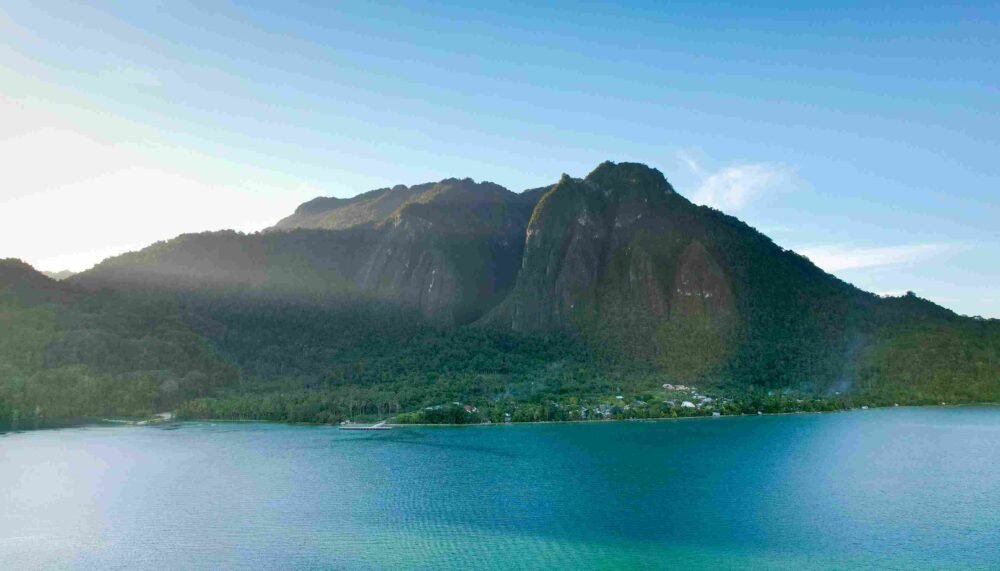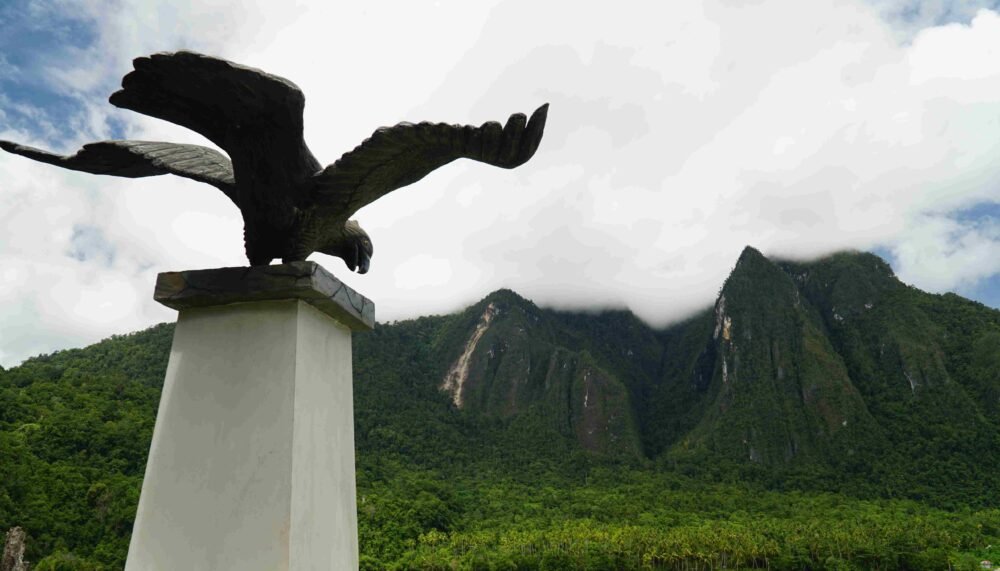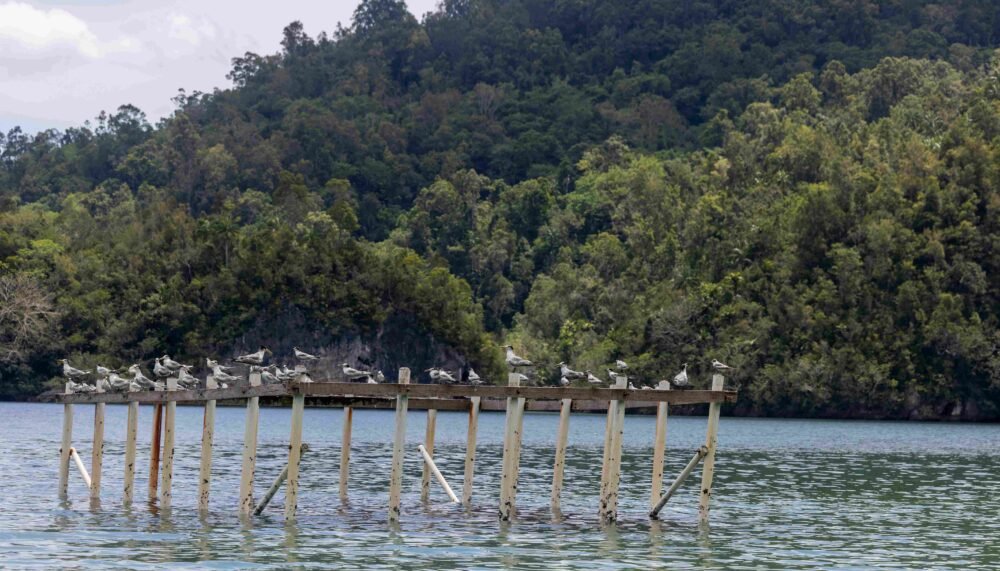Word: Ayu Arman
On the summit of Mount Emansiri, in the village of Lobo, rests the ancient tale of the giant eagle known as Garuda, while in its valley, unfolds the poignant story of the Dutch as they established their settlement for the first time.

As I entered the waters of Lobo, my gaze was immediately drawn to the magical energy emanating from Mount Emansiri towering above. It is said that the peak of this cone-shaped mountain is always shrouded in thick white clouds, much like what I witnessed that day.
The mountain, with its grandeur and simplicity, is a part of the planetary landscape that, for me, can evoke spiritual emotions. Mountains emit a “natural energy” that is high and distinct from the “natural energy” found in lowlands. This happens because a mountain is a cosmic being – rocks form its bones, lava is its flowing blood, trees and grass are its hair, and clouds and mist are its breath. Sullivan (1955) suggests that the complete portrayal of a mountain is a holistic manifestation of life.
Perhaps, it is this natural energy that attracted me to stand upright at the bow of the speedboat, gazing perfectly towards the summit of Emansiri. Meanwhile, dozens of birds perched and soared on either side, as if welcoming our boat’s arrival as we entered the waters of the village of Lobo, once known as the area of Janggauru Sea in the local Mairasi language.

As I gazed at Emansiri from a distance, my mind instantly recalled the journeys of sailors and traders from outside Papua in the past. Travelers and merchants who traversed this area likely always anchored their ships at the foot of the mountain to rest. The village of Lobo became the only lowland amidst the mountain cliffs and rocks created by sea erosion, making it the most suitable place to anchor. True to its original name, that is the position of Lobo. The name of the village originates from the local term “Awe Wamba,” meaning a harbor. Later, the Portuguese altered it to “Lobo”, and when the Dutch arrived, it was changed again to “Merkus-oord.”
The people of Lobo consider Emansiri a sacred place. During my visit to this village, I saw the Iamba Monument. This monument, erected by the Indonesian Expedition Team in 2016, stands tall, facing the mountain peak and the village of Lobo. Meanwhile, in another corner, the old Fort Du Bus monument, built in 1828, stands tall as well.

Our guide then introduced me to Mr. Leonardo Sisauta, the former village head of Lobo. Mr. Leonardo is one of the residents of Lobo who had climbed to the summit of Emansiri, that is said to had been the nest of the Iamba, the giant eagle, known for swooping down from the mountaintop, seizing canoes, and preying on people crossing the bay waters.
“The first people who saw the giant eagle were residents of the Mairasi tribe living around the inland of Janggauru Beach. It is said that the appearance of the bird was always marked by a loud and startling screech. Its wingspan was wide, and its claws were deadly when attacking. Almost no one escaped its pursuit. Our ancestors dared not live on the coastal shores. They preferred to live in the inland forests until one day the giant eagle was shot by white-skinned people with rifles and a pack of wolves, and only afterwards some residents from the inland dared to venture to the coastal shores of the bay,” recounted Mr. Leonardo.
He indeed couldn’t directly prove the truth of the existence of that bird, even though he had climbed Emansiri. At the mountain’s peak, he found no traces of it. Nevertheless, the view from the mountaintop was incredibly beautiful. As far as the eye could see, the entire expanse of Triton Bay and the Kei Islands, Maluku, unfolded.
As for the tale of the giant eagle, also known as the Garuda, it has become a folklore that continues to be passed down from generation to generation. Mr. Leonardo himself heard the story in the 1960s when he was still a child. To this day, the story of the giant eagle persists. In fact, Iamba has become a symbol for the Infantry Battalion 764 Kaimana, known as Iamba Baua, meaning the Guardian Garuda from the Eastern Horizon.
The oral accounts of the kamitua (the elders) about the Iamba bird that has become a legend in Lobo might bear some truth. Papua’s forests are known to be the habitat of the Harpyopsis novaeguineae. They prey on large creatures. They are also known as the Papua harpy eagles or Papua eagles. Their length range from 75 to 90 cm; their wingspans are about 121 to 157 cm, and their average body masses are 1.6 to 2.4 kg.
However, these Papua eagles are not as large as the ancient predatory eagles from the late Miocene. One of such species is the Haast’s eagle, one of the largest birds ever found in northwest Argentina, central United States, and New Zealand. The extinct giant predatory eagle weighed up to 15 kilograms, with claws reaching 9 centimeters in length and a wingspan of nearly 3 meters. Nevertheless, this eagle species went extinct about 800 years ago. Iamba might be a species of ancient predatory eagle from the late Miocene. Their habitat was in tropical rainforests.

If today we can still find giant banana trees reaching heights of 25 meters in the Papua forest, it is possible that 800 years ago, these giant predatory eagles also existed on Mount Emansiri. The Papua forest at that time was dense, covering all views and untouched by anything from the outside world.
Meanwhile, the story of white people shooting the giant eagle with rifles and using dogs and wolves as bait, as explained by the local residents, remains ambiguous. Some circulating stories suggest that the white people threw wolves as bait for the bird. When the bird descended to seek its prey, they shot it. The bird is believed to have an exceptionally large size, capable of taking boats from the sea, and then preying on sailors.
Some other stories state that the dogs were tied and beaten to make them howl, to lure the eagle nesting on Mount Emansiri out in search of prey. When the bird flew over the dogs, the white people shot it, and eventually, the bird fell.
One interesting aspect of the story of Kampung Lobo is the complex origin of its name. The name “Lobo” comes from the Portuguese word “loup,” meaning a wolf. This refers to an island inhabited by dogs and wolves. Thus, the name of the village “Awe Wamba” several years later changed to Lobo. Can we assume that the visiting Portuguese sailors gave the name?

It can be. In Zeemansgids voor den Oost-Indischen Archipel (1901), it is recorded that the waters of Janggaru were once navigated by Portuguese sailors between 1512 and 1607.
To this day, dozens of stray dogs can still be found. While talking with Mr. Leonardo Sisauta, I heard the long howls of dogs echoing in the broad daylight.
“Sir, why are the dogs making those sounds?” I asked.
“This is where the dogs are. In the past, before the villagers learned about religion, dogs and wolves here could be used as messengers or intermediaries to harm people with black magic. Perhaps due to the abundance of dogs and wolves, the white people named this island Lobo.”
Whether it is real or merely a myth, the story told by Mr. Leonardo is part of the living folklore that has grown and developed in the Lobo community, learned through generations, thus becoming the origin history of Kampung Lobo.
Kampung Lobo was officially recognized when the Dutch established the Merkus-oord settlement and the first military post in Papua named Fort Du Bus, inaugurated on August 24, 1828. This marked the beginning of human habitation in Lobo.
However, the history of the Merkus-oord settlement, inhabited by about 170 members of the Triton Expedition team, hides a tragic and heartbreaking story. In The Price of Knowledge Science, Imperialism, and the 1828 Triton Expedition (2020), Sven Rouschop tells that shortly after the settlement was opened, one by one, expedition members fell ill to miasmic diseases, toxins from the foul air due to deforestation and land clearing around the fort.
Out of the total 170 expedition team members, 68 fell sick and subsequently died. Only 20 Javanese laborers seemed unaffected by the disease. Consequently, the settlement buildings were dismantled, and the remaining expedition members returned to Ambon. What was left behind were the fort and ancient graves that can still be found in Lobo today.
There is also a story that Bung Karno (Indonesia’s first president, Sukarno) once visited Kampung Lobo under the alias Sabakula. Nikolas Werwete, a resident of Kampung Kokoroba on Arguni Island, testified to the people of Lobo. Nikolas once escorted Bung Karno by boat to Kampung Lobo. However, at that time, he did not know that the man claiming to be Sabakula was Bung Karno. It was only several years later that he realized Sabakula was Bung Karno when he saw pictures of Bung Karno during his presidency of the Republic of Indonesia.
He remembered seeing a face similar to Bung Karno’s in Kampung Lobo. At that time, he was asked to fetch water to fill the boat carrying Bung Karno and several others. Bung Karno’s visit to Lobo was very brief. He merely surveyed the land of Lobo and took wood from the timomor tree. This tree could only grow on the rocks around Lobo’s waters and was exposed to sea waves. The wood was exceptional, hard as iron, and supposedly became one of Bung Karno’s command staffs.
The story of the giant eagle or hawk or Garuda and Bung Karno’s presence in Lobo has been passed down through generations, has become a traditional belief of the Lobo community. They believe that Emansiri is the origin of Sang Garuda, symbolizing Pancasila, and the straight timomor wood became the main material for Bung Karno’s command staff.
This story has now become part of Lobo’s folklore, a traditional belief that has been passed down from generation to generation through verbal communication, non-verbal behavior, and physical evidence such as artifacts from ancient times. Thus, the folklore remains alive amidst the rapid changes of time.
This story also intrigued Puan Maharani, Bung Karno’s granddaughter, to visit Kampung Lobo during the 2016 NKRI Expedition in the West Papua Corridor. She then proposed Lobo as a historical tourism destination in Kaimana. Not only does Lobo boast natural beauty against the backdrop of the majestic Gunung Emansiri, it also holds the ancient story of the giant eagle (Garuda) and the history of Indonesia’s struggle in uniting Papua within the embrace of the Republic of Indonesia.***

